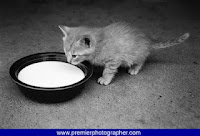 |
| Some cats don't tolerate milk, some do |
Spaying or neutering a cat will cause it to gain weight.
Reality: When spaying or neutering occurs around 6 months of age, it coincides with a cat's natural decrease in metabolism. This is the time that cat owners should switch from kitten food to a quality adult food. Making sure that your cat is balancing dry food with 3-6oz daily canned food will help with weight control, as canned food contains about 80% water. Your cat will feel full while taking in fewer calories than if she were eating a dry-food-only diet of highly concentrated calories. Think about it this way: eating a bowl of salad or hearty soup is often more filling than an calorie-equivalent serving of potato chips or cookies.
The other factor in feline weight gain is usually inactivity. As a cat matures, he tends to play less frequently and less vigorously - possibly as much due to how we interact with our cats as due to their age. We must often come up with ways to keep our mature cats active and interested in activity, such as food puzzles, scheduled "play times", and training sessions with a portion of the daily kibble as a reward. Yes, you can teach an old cat new tricks!
Pregnant women should not own cats.
Reality: It is true that some cats are infected with the parasite Toxoplasma gondii which can cause a disease called toxoplasmosis. It is possible for this disease to be contracted through the cleaning of the litterbox. However, this disease can also be contracted through the eating of undercooked meat (50% of cases), eating unwashed produce or through gardening without gloves, so cats are not the only culprit.
Instead of thinking of re-homing your cat, have other people empty the litter box daily. Toxoplasma oocysts (eggs) aren't infectious for the first 24 hours after they're excreted, so daily cleaning (which your cat prefers, anyway) will decrease the risk of tranmission even further.If no one else can clean the litter, wear gloves and a mask to clean and wash your hands thoroughly afterwards. Don't plan to get a kitten while pregnant, and try to limit your cat's hunting. If you feed a raw diet, it would be best to discontinue doing so while pregnant, both to decrease the risk to your cat, and also to limit the handling of raw meat while pregnant.
Cats are nocturnal.
 |
| Glowing tapetum lucidum |
Garlic is a good, natural flea repellant for my cat.
Reality: Whether or not garlic is a good flea repellant, all members of the genus Allium (onion, garlic, leek, chives, shallots, and scallions) can be poisonous to both dogs and cats. Toxicity can cause damage to the red blood cells (RBC), resulting in Heinz body anemia. In particular, cats are 2 to 3 times more susceptible to RBC damage from these components than other species. While specific studies have not been done with garlic as to the safe levels of ingestions, acute onion toxicosis occurs in animals that eat more than 0.5% of their body weight at one time (less than 2 Tbsp. for a 10lb. cat). However, smaller doses given regularly over a period of time will cause the same problem.
Dietary ash and magnesium are what cause feline urinary crystals.
 |
| Struvite crystals in urine |
There are many more myths out there, so stay tuned for Part Two! Are there any myths you have heard that you want us to address?

Thank you so much for such an informative piece of information :)
ReplyDeleteIf anyone interested similar one's have a look here
Bestreviewtop
Thanks